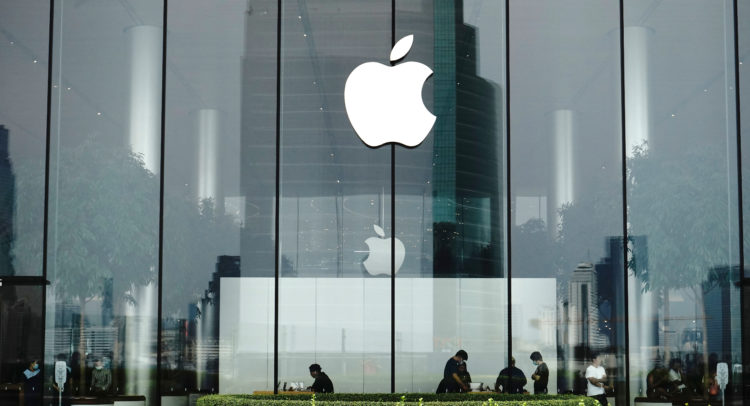Tech maker Apple (AAPL) is facing a dilemma that a host of other firms have had to face in the last several months. With prices spiking everywhere, the old pay packages don’t go as far as they used to, and they never really went all that far, to begin with. Now, faced with potential unionization at its Apple Store locations, Apple is reconsidering its pay practices.
Such a move is a mixed bag for investors, as it solves a problem but causes one as well. Considering the entirety of Apple news, however, I’m willing to be bullish. That’s especially the case with Apple’s Worldwide Developer’s Conference (WWDC) coming up next week. That may solve some of Apple’s problems as well.
The last 12 months for Apple stock are up on average, but not as up as they were at one point. Apple kicked off the last 12 months at around $124 per share. A slow and steady rise let it crack $180 with the new year, but a series of ups and downs brought us back to around $150.
The latest news doesn’t seem to be fazing investors much one way or the other. Apple plans to hike pay packages for its hourly workers, with starting pay going to $22 an hour. That’s up 45% from 2018, noted a Wall Street Journal report. It won’t just be hourly workers getting the pay bump, either; starting salaries are also in line to get a hike.
Wall Street’s Take
Turning to Wall Street, Apple has a Strong Buy consensus rating. That’s based on 21 Buys and six Holds assigned in the past three months. The average Apple price target of $186.61 implies 24.9% upside potential.

Analyst price targets range from a low of $160 per share to a high of $210 per share.
Apple’s Investor Sentiment is Somewhat Mixed
On the surface, Apple’s stock has a lot of faith behind it. The company currently has a Smart Score of 9 out of 10 on TipRanks. That’s the second-highest level of “outperform,” suggesting an excellent chance that Apple will outperform the broader market. Not everyone agrees with that sentiment, but there are many that do.
Hedge funds are coming in on Apple’s side in increasing numbers. The TipRanks 13-F Tracker shows that hedge funds added 3.6 million AAPL shares to their collective portfolios last quarter, which is the second time the amount has been raised since September 2021. With this raise, hedge fund involvement is back to around where it was in July 2021.

Meanwhile, insider trading at Apple is significantly Sell-weighted. In the last three months, Sell transactions outpaced Buy transactions 10 to three. Expanding the look back to the last 12 months, we find that Sell transactions still outpace Buy transactions, but this time by 30 to 13. Insider purchases are coming back, but not at the rate that selling takes place.
Retail investors that hold portfolios on TipRanks are generally positive, though that’s been slipping in recent days. In the last seven days, TipRanks portfolios that hold Apple stock are down 0.2%. However, in the last 30 days, those same portfolios are up 1.5%.
Finally, there’s Apple’s dividend history to consider. Though the size of the dividend isn’t substantial, it has behaved how income investors would most prefer. It was paid regularly over the last nine years—even during the pandemic—and it has been steadily increasing over time.
All Part of the Job
Apple basically telling investors that it’s about to spend a lot more money on workers isn’t likely to do it any favors in the market, going forward. Sure, it’s important—you can’t do the job without workers to do it—but paying more for the same job is a drag on income.
Yet there’s little that Apple can do in that case. It has to take this hit or potentially suffer a much worse hit later. A union Apple shop will add a layer of complexity to operations and make them tougher to predict going forward.
However, Apple has other issues to address. For instance, its Safari browser just celebrated a major milestone, as it crossed the one billion user mark. It still has fewer users than Chrome, which also has over a billion users. Having the second most used mobile browser around is a welcome development in its own right, though.
Supply-chain issues are also hitting Apple, but it’s working to move around them. For instance, the COVID-19-related lockdowns in Shanghai prompted Apple to move some of its iPad production operations to Vietnam instead. Apple has been working with suppliers to build up more stock against potential shortfalls.
However, reports suggest that this isn’t being taken well across the entire supplier pool. Tech suppliers are concerned that demand for Apple products may wane as energy costs continue to rise and inflation spikes just about everywhere else. That’s not the first time that someone’s expressed concern over the consumer losing his or her taste for Apple hardware.
Yet, that point may also be addressed in the next several days. Apple is planning its Worldwide Developer’s Conference (WWDC) event, which typically features some of the big new advances in Apple hardware.
Already, some significant upgrades in Apple software are slated to hit, as the company updates notifications, messages, multitasking capabilities, and more.
Take all of these points together, and you have a reasonably good picture ahead for Apple but also some major potential pratfalls. A cooling economy coupled with spiking prices for food and heat isn’t a good position from which to try and sell pricey phones. That’s especially true for those whose last phone purchase is still up and running.
Sure, there will always be a certain portion of the population who must have the latest Apple device at all costs, but counting on this to be a major market is not the strategy anyone wants to base a retirement plan on.
What Apple truly needs right now is a completely new must-have device. Most of Apple’s new products have been incremental advances to old releases (new iPhones, new iPads, and so on).
Apple doesn’t really need a new iPad; it needs the next iPad. Even that will likely prove a tough sale in an environment where people are struggling just to keep the lights on and the kids fed.
Concluding Views
Right now, things are looking good for Apple. The stock has trended higher over the past year yet is still trading well below even its lowest price targets. That’s about as decent a buy-in point as Apple gets. Throw in a dividend so rock solid that it survived a pandemic, and that makes it even more attractive.
Even as I stand bullish on Apple, it’s worth pointing out that investors may want to keep the exits in sight. Apple will be subject to downward pressure in a recession. It’s built a wonderful walled garden of supporters over the years, and if the WWDC produces anything truly exciting next week, that could spark some growth.
Yet, it will find itself subject to the same issues that many other retailers are facing: growing expenses and declining demand. That adds up to potential bad news, but for right now, things look fairly decent at Apple.
Read full Disclosure









